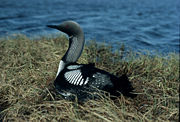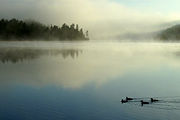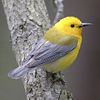Loon
| Divers or Loons | ||||||||||||||||
|---|---|---|---|---|---|---|---|---|---|---|---|---|---|---|---|---|
 Common Loon or Great Northern Diver
Gavia immer |
||||||||||||||||
| Scientific classification | ||||||||||||||||
|
||||||||||||||||
| Species | ||||||||||||||||
|
Gavia adamsii |
The loons (North America) or divers (UK/Ireland) are a group of aquatic birds found in many parts of North America and northern Eurasia. All living species of loons are members of one genus, Gavia,[1] family, Gaviidae, and order Gaviiformes all of their own.
The loons are the size of a large duck or small goose, which they somewhat resemble in shape when swimming. Their plumage is largely black-and-white, with grey on the head and neck in some species, and a white belly, and all species have a spear-shaped bill.
The European name "diver" comes from the bird's habit of catching fish by swimming calmly along the surface and then abruptly plunging into the water. The North American name loon comes from the bird's haunting, yodelling cry.
Contents |
Ecology
Loons are excellent swimmers, using their feet to propel themselves above and under water and their wings for assistance. Because their feet are far back on the body, loons are poorly adapted to moving on land. They usually avoid going onto land, except when nesting.
All loons are decent fliers, though the larger species have some difficulty taking off and thus must swim into the wind to pick up enough velocity to get airborne. Only the Red-throated Diver can take off from land. Once airborne, their considerable stamina allows them to migrate long distances southwards in winter, where they reside in coastal waters. Loons can live as long as 30 years.
Diet
Loons find their prey by sight. They eat fish, amphibians, and crustaceans. Specifically, they eat crayfish, frogs, snails, salamanders and leeches. They prefer clear lakes because they can see their prey more easily through the water. The loon uses its pointy bill to stab or grasp prey. They eat vertebrate prey headfirst to facilitate swallowing, and swallow all their prey whole.
To help digestion, loons swallow small pebbles from the bottoms of lakes. Similar to grit eaten by chickens, these gastroliths may assist the loon's gizzard in crushing the hard parts of the loon's food such as the exoskeletons of crustaceans and the bones of frogs and salamanders. The gastroliths may also be involved in stomach cleaning as an aid to regurgitation of indigestible food parts.
Loons may inadvertently ingest small lead pellets, released by anglers and hunters, which will slowly lead to the loon's death by lead poisoning. Jurisdictions that have banned the use of lead shot and sinkers include Maine, New Hampshire, Vermont, some areas of Massachusetts, Yellowstone National Park, Great Britain, Canada, and Denmark.[2]

Reproduction
During the summer, loons nest on freshwater lakes and/or large ponds. Smaller bodies of water (up to 0.5 km²) will usually only have one pair. Larger lakes may have more than one pair, with each pair occupying a bay or section of the lake.
Loons build their nests close to the water, preferring sites that are completely surrounded by water. They may use the same site from year to year. Loons will use a variety of materials found nearby to build their nests including pine tree needles, leaves, grass, moss, and sometimes clumps of mud. Both the male and female help with nest building and incubation, which usually lasts 26-31 days. If the eggs are lost, the pair may re-nest, often in the same general location.
Usually one or two eggs are laid in June. Loon chicks are precocial, able to swim right away, but are often seen riding on their parents' back. This behavior allows the chicks to rest, conserve heat, and avoid predators such as large carnivorous fish, snapping turtles, gulls, eagles, and crows. After a day or two, chicks cease returning to the nest but remain in their parent's company.
Chicks remain with and are fed exclusively by their parents for about eight weeks. After eight weeks, chicks will begin to dive for some of their own food. By 11 or 12 weeks of age, chicks are able to gather almost all of their own food and may be able to fly.
A pair may mate for life, although banding studies have shown that loons will sometimes switch mates after a failed nesting attempt and even between nesting attempts in the same season.[3] Male loons appear more faithful to breeding territories than to mates.[4]
Systematics and evolution

All living species are classed in the genus Gavia.
- Red-throated Diver or Red-throated Loon, Gavia stellata.
- Black-throated Diver or Arctic Loon, Gavia arctica.
- Pacific Diver or Pacific Loon, Gavia pacifica - formerly included in G. arctica
- Great Northern Diver or Common Loon, Gavia immer.
- White-billed Diver or Yellow-billed Loon, Gavia adamsii
Relationships and evolution
The loons were formerly often considered to be the most ancient of the northern hemisphere bird families; this idea grew basically out of the perceived similarity of shape and (probably) habits between loons and the entirely unrelated extinct Cretaceous order Hesperornithiformes. However, the two groups are merely the product of convergent evolution and adapted in a similar way to a similar ecological niche.[5]
More recently, it has become clear that the Anseriformes (waterfowl) and the Galliformes are the most ancient groups of modern birds, while loons belong to a more modern radiation. What is also generally accepted as a fact is that loons and grebes are not closely related at all, but rather one of the most stunning examples of convergence in the known birds. The Sibley-Ahlquist taxonomy still allied the loons with the grebes in its paraphyletic "Ciconiiformes", and it is almost certain that the relationships of loons lie with some of the orders united therein. Alternatively, loons have tentatively been considered to share a rather close relationship with waders, penguins or procellariiform seabirds.[6]
The conflicting molecular data is not much resolved by the fossil record. Modern loons are only known with certainty since the Eocene, but by that time almost all modern bird orders are known or strongly suspected to have existed anyway. The Late Eocene to Early Miocene genus Colymboides was widespread in Western and Central Europe; it is usually placed in the Gaviidae already, but may actually be more primitive; it is quite distinct from modern loons and could well be paraphyletic. From the genus Gavia, about a dozen fossil species have been discovered to date, which are known from the Early Miocene onwards and had a more southerly distribution, like today's California, Florida and Italy:

- Gavia egeriana Švec, 1982 (Early Miocene of Czechoslovakia -? Late Miocene of E USA)
- Gavia schultzi Mlíkovský, 1998 (Middle Miocene of Sankt Margarethen, Austria)
- Gavia sp. (Calvert? Middle Miocene or Maryland, USA)[7]
- Gavia spp. (Middle Miocene of Steinheim, Germany) - 3 species[8]
- Gavia brodkorbi (Late Miocene of Orange County, USA)
- Gavia moldavica Kessler, 1984 (Late Miocene of Chişinău, Moldova)
- Gavia paradoxa Umanska, 1981 (Late Miocene of Čebotarevka, Ukraine)
- Gavia concinna Wetmore, 1940 (Late Miocene/Early Pliocene -? Late Pliocene of W and SE USA)[9]
- Gavia fortis Olson & Rasmussen, 2001 (Yorktown Early Pliocene of Lee Creek Mine, South Carolina, USA)
- Gavia sp. (Early Pliocene of Kerč Peninsula, Ukraine)[8]
- Gavia spp. (Yorktown Early Pliocene of Lee Creek Mine, South Carolina, USA) - 2 species
- Gavia howardae Brodkorb, 1953 (Middle Pliocene of San Diego, California, USA)[10]
- Gavia cf. concinna (Middle Pliocene of San Diego, California, USA)[11]
- Gavia palaeodytes Wetmore, 1943 (Middle Pliocene of Pierce, Florida, USA)[12]
- Gavia sp. (Early Pleistocene of Kairy, Ukraine)[8]
- Gavia cf. immer (Pleistocene of California and Florida, USA) - possibly a G. immer paleosubspecies[13]
"Gavia" portisi from the Late Pliocene of Orciano Pisano (Italy) is known from a cervical vertebra that may or may not have been from a loon. If so, it was from a bird slightly smaller than Common Loon. Older authors were quite sure the bone was indeed from a Gavia and even considered G. concinna a possibly junior synonym of it. This is now regarded as rather unlikely for reasons of biogeography. Interestingly, an Early Pliocene loon skull form Empoli (Italy) was referred to G. concinna. The vertebra may now be lost, making "G." portisi a nomen dubium.[14]
In addition, there are some much older forms that are sometimes assigned to the Gaviiformes. From the Late Cretaceous, the genera Lonchodytes (Lance Formation, Wyoming) and Neogaeornis (Quinriquina Formation, Chile) have been described; the latter might have been a primitive loon, but possibly a hesperornithiform, and both have sometimes been allied with the orders which are considered related to loons. Doubtfully valid and surrounced by considerable dispute[15] is the supposed Late Cretaceous loon Polarornis (Seymour Island, Antarctica). Eupterornis from the Paleocene of France has some features reminiscent of loons, but others seem more similar to Charadriiformes such as gulls (Laridae). A piece of a carpometacarpus supposedly from Oligocene rocks near Lusk, Wyoming was described as Gaviella pusilla, but this also shows some similarities to the plotopterids.[16] Parascaniornis, sometimes allied to the loons, has more recently determined to be a junior synonym of the hesperornithiform Baptornis.
Loons in popular culture
The Common Loon is the provincial bird of Ontario and is depicted on the Canadian one-dollar coin, which has come to be known affectionately as the "loonie".[17] It is also the official state bird of Minnesota,[18] and Mercer, Wisconsin promotes itself as the "Loon Capital of the World".[19] Loons are mentioned several times in the film On Golden Pond.
Footnotes
- ↑ Etymology: gavia, Latin for smew - a quite unrelated species that also happens to be a black-and-white marine fishing bird. It is not likely that the Ancient Romans had much knowledge of loons, as these are limited to more northern latitudes.
- ↑ If your jurisdiction is not listed here, this does not mean that lead shot and weights are legal. For a review of the impact of lead shot and alternatives, see Minnesota PCA (2007). For a review of gastrolith function, see Wings (2007).
- ↑ USFWS (2005)
- ↑ Montana FW&P (2007)
- ↑ This was proposed in the early 20th century already (Stolpe 1935).
- ↑ Olson (1985), Mayr (2004)
- ↑ USNM 1661, distal right tibiotarsus. Smaller than Common Loon: Wetmore (1941), Olson (1985).
- ↑ 8.0 8.1 8.2 Mlíkovský (2002: p.64)
- ↑ Known from skull and limb bones. Much like a large Black-throated Diver but stouter and heavy-billed like Common Loon. Has been considered possible junior synonym of G. portisi, but this is unlikely for reasons of biogeography: Brodkorb (1953), Mlíkovský (2002: p.64).
- ↑ Known from distal humerus pieces LACM 2111, 2133, 2175. Specimen LACM 2175 was initially listed as 2131. Maybe closest to Pacific Loon but smaller than Red-throated Diver; appears to be quite distinct: Brodkorb (1953).
- ↑ Specimen LACM 2142, a small piece of proximal left humerus. It is either from a small G. concinna or an unknown species: Brodkorb (1953).
- ↑ Known from a few limb bones. Roughly similar in size to Pacific Loon, but proportions seem to differ and apparently not close to any living species except maybe Red-throated Diver: Brodkorb (1953).
- ↑ Brodkorb (1953)
- ↑ Brodkorb (1953), Mlíkovský (2002: p.64, 256-257)
- ↑ See for example the discussion in Mayr (2004).
- ↑ Discussed in Olson (1985).
- ↑ Stewart (2004): p.143
- ↑ Heinrichs (2003): p.44
- ↑ Moran et al. (2005): p.78
References
- Brodkorb, Pierce (1953): A Review of the Pliocene Loons. Condor 55(4): 211-214. PDF fulltext DjVu fulltext
- Heinrichs, Ann (2003): Minnesota. Compass Point Books. ISBN 0756503159
- Mayr (2004): A partial skeleton of a new fossil loon (Aves, Gaviiformes) from the early Oligocene of Germany with preserved stomach content. J. Ornithol. 145: 281-286 doi:10.1007/s10336-004-0050-9 PDF fulltext
- Minnesota Pollution Control Agency (2007): Let's Get the Lead Out! Non-lead alternatives for fishing tackle. Version of June, 2007. Retrieved 2007-JUL-23.
- Mlíkovský, Jirí (2002): Cenozoic Birds of the World, Part 1: Europe. Ninox Press, Prague. ISBN 80-901105-3-8 PDF fulltext
- Montana Fish, Wildlife & Parks (Montana FW&P) (2007): Animal Field Guide: Common Loon. Retrieved 2007-MAY-12.
- Moran, Mark; Sceurman, Mark; Godfrey, Linda S. & Hendricks, Richard D. (2005): Weird Wisconsin: Your Travel Guide to Wisconsin's Local Legends and Best Kept Secrets. Sterling Publishing. ISBN 0760759448
- Olson, Storrs L. (1985): Section X.I. Gaviiformes. In: Farner, D.S.; King, J.R. & Parkes, Kenneth C. (eds.): Avian Biology 8: 202-214. Academic Press, New York.
- Stewart, Barry D. (2004): Across The Land: A Canadian Journey Of Discovery. Trafford Publishing. ISBN 1412022762
- Stolpe, M. (1935): Colymbus, Hesperornis, Podiceps:, ein Vergleich ihrer hinteren Extremität. J. Ornithol. 80(1): 161-247. [Article in German] doi:10.1007/BF01908745
- Wetmore, Alexander (1941): An Unknown Loon from the Miocene Fossil Beds of Maryland. Auk 58(4): 567. PDF fulltext DjVu fulltext
- United States Fish and Wildlife Service (USFWS) (2005): Common Loons at Seney NWR, June 2005. PDF fulltext
- Wings, Oliver (2007): A review of gastrolith function with implications for fossil vertebrates and a revised classification. Acta Palaeontologica Polonica 52: 1-16 PDF fulltext
Identification
- Appleby, R. H., S. C. Madge and Killian Mullarney (1986) Identification of divers in immature and winter plumages British Birds 79(8): 365-91
External links
- Video of nesting loons. Video captures the laying and hatching of two eggs on Lake George in Minnesota.[1]
- Tree of Life Gaviidae
- Loon sounds
- Loon videos on the Internet Bird Collection
- Loon Preservation Committee
- Diving Birds of North America, by Paul Johnsgard
|
||||||||||||||||||||||||||
